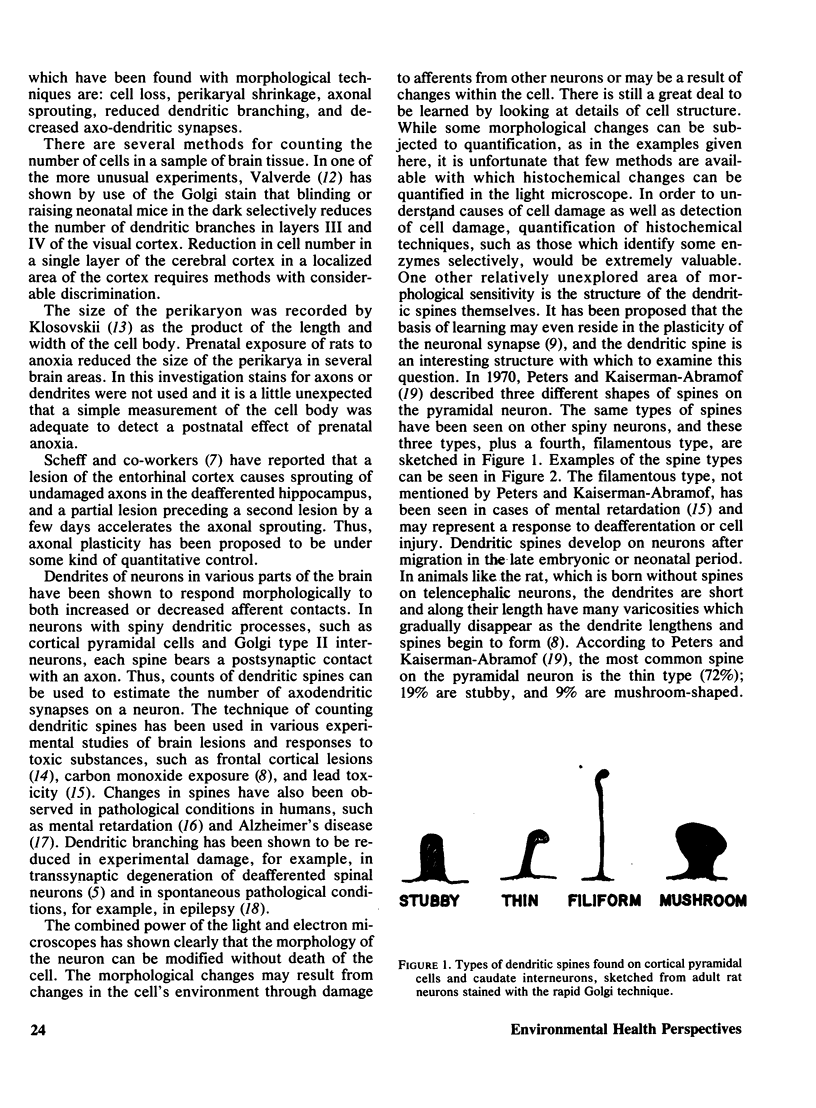Abstract
Both behavior and morphology can be altered by exposure of the CNS to toxic substances. The brain is an organ with considerable structural redundancy and this presumably accounts for some of the ability of the CNS to maintain normal function in the presence of some structural damage. Compensation for damage may also occur through a form of "learning" due to the biochemical and morphological plasticity of the CNS. Examples of these kinds of compensation are enzyme induction and axonal sprouting. Compensatory changes such as these are likely to require days or weeks to develop. On the other hand, short-term, reversible effects of substances such as drugs are not likely to cause morphological changes at doses which affect behavior. The importance of appropriate quantitative data on both morphology and behavior in evaluation of the CNS toxicity of substances is evident.
Full text
PDF






Images in this article
Selected References
These references are in PubMed. This may not be the complete list of references from this article.
- Bernstein J. J., Wells M. R., Bernstein M. E. Dendrites and neuroglia following hemisection of rat spinal cord: effects of puromycin. Adv Neurol. 1975;12:439–451. [PubMed] [Google Scholar]
- Cragg B. G. Plasticity of synapses. Br Med Bull. 1974 May;30(2):141–144. doi: 10.1093/oxfordjournals.bmb.a071184. [DOI] [PubMed] [Google Scholar]
- Lovenberg W., Goodwin S., Wallace E. F. Molecular properties and regulation of dopamine-beta-hydroxylase. Adv Biochem Psychopharmacol. 1975;13:77–93. [PubMed] [Google Scholar]
- Mandell A. J. Neurobiologocal mechanisms of presynaptic metabolic adaptation and their organization: implications for a pathophysiology of the affective disorders. Adv Biochem Psychopharmacol. 1975;13:1–32. [PubMed] [Google Scholar]
- Mehraein P., Yamada M., Tarnowska-Dziduszko E. Quantitative study on dendrites and dendritic spines in Alzheimer's disease and senile dementia. Adv Neurol. 1975;12:453–458. [PubMed] [Google Scholar]
- Norton S., Culver B. A Golgi analysis of caudate neurons in rats exposed to carbon monoxide. Brain Res. 1977 Sep 2;132(3):455–465. doi: 10.1016/0006-8993(77)90194-9. [DOI] [PubMed] [Google Scholar]
- Norton S. Hyperactive behavior of rats after lesions of the globus pallidus. Brain Res Bull. 1976 Mar-Apr;1(2):193–202. doi: 10.1016/0361-9230(76)90069-1. [DOI] [PubMed] [Google Scholar]
- Peters A., Kaiserman-Abramof I. R. The small pyramidal neuron of the rat cerebral cortex. The perikaryon, dendrites and spines. Am J Anat. 1970 Apr;127(4):321–355. doi: 10.1002/aja.1001270402. [DOI] [PubMed] [Google Scholar]
- Purpura D. P. Dendritic spine "dysgenesis" and mental retardation. Science. 1974 Dec 20;186(4169):1126–1128. doi: 10.1126/science.186.4169.1126. [DOI] [PubMed] [Google Scholar]
- Ryugo D. K., Ryugo R., Globus A., Killackey H. P. Increased spine density in auditory cortex following visual or somatic deafferentation. Brain Res. 1975 Jun 6;90(1):143–146. doi: 10.1016/0006-8993(75)90689-7. [DOI] [PubMed] [Google Scholar]
- Scheff S., Benardo I., Cotman C. Progressive brain damage accelerates axon sprouting in the adult rat. Science. 1977 Aug 19;197(4305):795–797. doi: 10.1126/science.887924. [DOI] [PubMed] [Google Scholar]
- Scheibel M. E., Crandall P. H., Scheibel A. B. The hippocampal-dentate complex in temporal lobe epilepsy. A Golgi study. Epilepsia. 1974 Mar;15(1):55–80. doi: 10.1111/j.1528-1157.1974.tb03997.x. [DOI] [PubMed] [Google Scholar]






